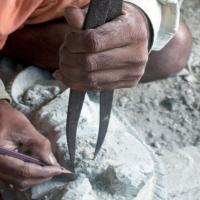Design Gallery
Soap Stone Carving, Mysore
The craft of soap-stone carving
by
Mysore in Karnataka state is hub of cultural arts and handicrafts. The unique soapstone carving also adds weight to the cultural wealth of Mysore. Mysore is the center of Soapstone carving due to abundant availability of soapstone deposits. Many skilled artisans are engaged in carving soapstone to create fascinating artefacts with graceful expressions. Soapstone locally called as Krishna Shila is the basic raw material available in brown, tan, yellow, red, gray, pink, white and black colors. Soapstone can be easily carved due to its soft nature which consists mostly of lac.The highly skilled artist with his great effort makes the art piece by following several steps such as stone cutting, marking, rough carving, detailed carving and final finishing. Fine quality soap stones are procured and stored in bulk. The big block of stone is first roughly cut into proper shape. Then, the proportions are marked on the stone using divider tool. The unwanted stone portion is removed during the carving process. The reference paper with the design is placed on the stone and the design is traced on the stone. Based on the traced design, the shape of the idol is first roughly cut and then carving is done with chisel and hammer. The rough carvings are made first. Once the base shape of idol is revealed, then the detailed carvings are made with sharp edged chisels and jumpers. The idol is rubbed with stone to smoothen the outer surface. Finally, the idol is coated with metal paste to obtain the glossy finish. Different types of traditional products include Images of Lord Krishna with flute, Lord Hanuman, Lord Rama with Sita and Laxmana and Shaneeswara. Contemporary forms also carved based on the market requirement.
For more details:
http://dsource.in/resource/soap-stone-carving-mysore























